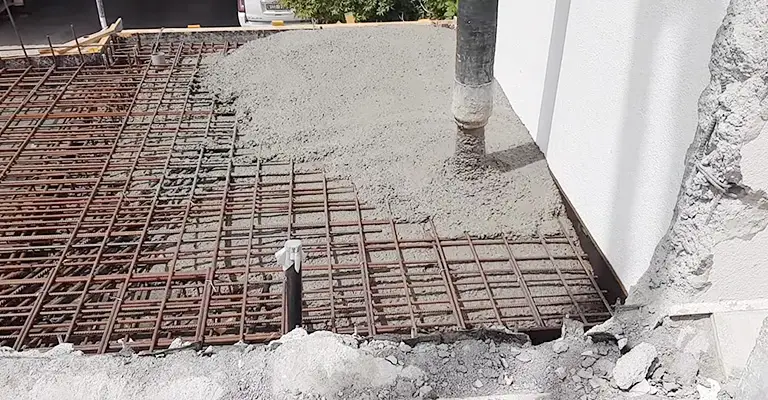Concrete is a versatile and widely used construction material known for its durability and strength. It is commonly used for foundations, driveways, and various other applications.
However, when it comes to pouring concrete over rubble, certain considerations must be taken into account to ensure a successful and long-lasting result.
You have the option to pour concrete over it, but before doing so, it’s recommended to rent a wacker plate and compact it down. This surface is well-suited for pouring concrete over after using the wacker plate.
The use of rubble in foundation concrete is generally not recommended. The rubble causes the concrete to crack because it breaks its continuity.
In this guide, we will explore the possibility of pouring concrete over rubble, discuss the factors that need to be considered, and provide helpful tips for achieving a solid and stable concrete surface.
Can Concrete Be Poured Over Backfill?
As long as concrete’s purpose and application are deemed safe, it can be poured over backfill.
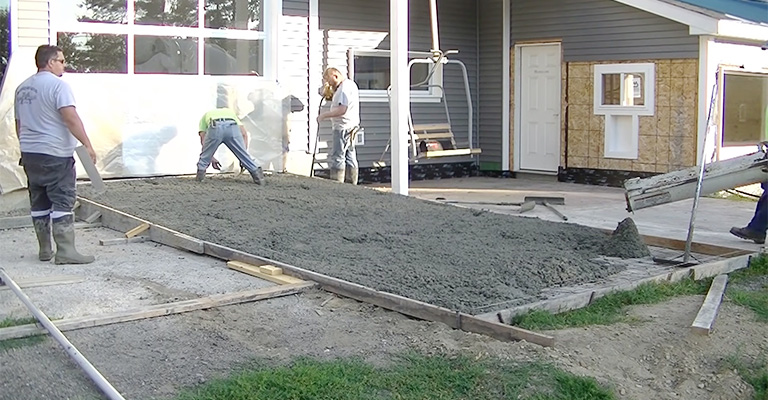
Bearing Capacity
In contrast to concrete, soil has limited bearing capacity, and backfill may need to be adequately compacted before concrete is poured.
The soil should be compacted in 150mm raises to at least 95% proctor density in order to prevent settlement on the concrete member.
Suitable ground improvement measures must be taken if the bearing capacity still falls short.
Protective Layer
It is generally recommended to place a protective layer of 100mm sand and 150mm PCC beneath the grade concrete.
They protect any reinforcements that may corrode by acting as a moisture and physical barrier. For large areas, HDPE films/sheets are also used.
Drainage
If the pour is below the water table, subsoil drainage trenches would greatly assist. It is important to create drainage pathways to ensure soil integrity as well as to prevent leeching of chemicals from water into concrete.
Can You Pour Concrete Over Rubble?
Concrete can be poured over rubble. Prior to pouring concrete, you must take some considerations into account.
The rubble must be crushed into smaller pieces before being leveled so that it can be easily leveled.
In order to avoid unnecessary headaches down the road, you should prepare your foundation before pouring concrete if you plan on pouring a concrete slab.
A Good Foundation Important
Investing in a solid foundation is vital to a structure’s success. It’s important not to overlook the importance of a good foundation for your house. A house cannot be repaired or replaced once it has already been inhabited.
When constructing a foundation, therefore, adequate precautions must be taken. Houses often experience foundation issues.
Cracked floors are commonly caused by poorly placed foundations. The ground under your home can cause cracks in the flooring if it is unstable.
Your house’s foundation can be strengthened, however. You can protect your home from foundation issues by understanding the factors that make a foundation stable.
What Is The Ideal Base For A Concrete Foundation?
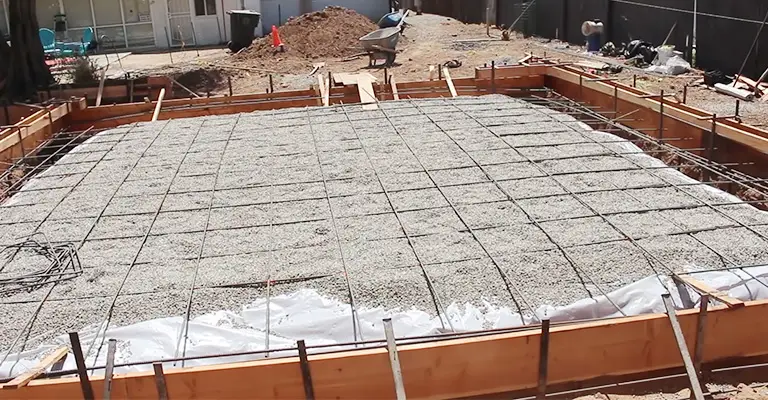
The use of concrete for driveways, sidewalks, and structural foundations has been widespread for decades. In concrete slabs, cement, sand, and gravel are mixed together.
For this reason, certain manufacturers specify the aggregates they believe will best suit their products in the mix. Because aggregates contribute to slab strength in different ways, each type contributes differently.
A finishing product’s strength can also be affected by the type of particles as well as the size ratio of the aggregate to the cement. Stone dust, crushed stone, and coarse aggregate #57 are the best bases for concrete slabs.
A variety of characteristics are found in each element, including density, porosity, permeability, hardness, and durability. A material’s performance under certain conditions can be determined by its properties.
Nevertheless, when these three materials are combined, they produce concrete mixtures that provide a sturdy foundation that is tough, durable, and strong.
Can You Pour Concrete Over Dirt?
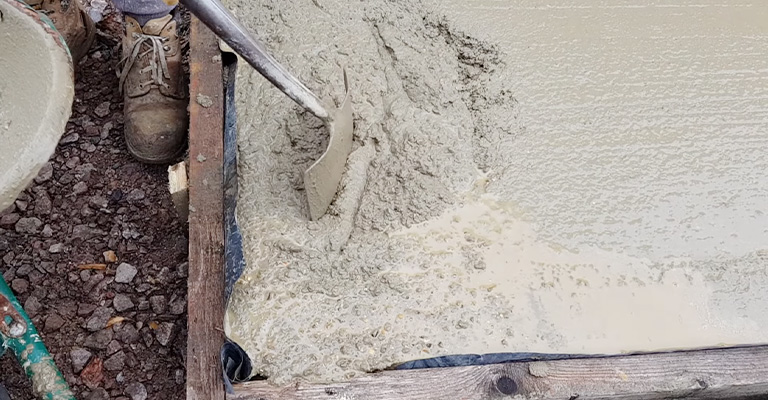
It is possible to pour concrete over any type of ground or surface. Pouring it on dirt, however, is more difficult than most people think.
Particularly when it comes to driveways and walkways. When pouring concrete on a surface, check a few things to make sure it’s a good surface.
Steps In Prepping A Concrete Foundation For A Driveway Or Walkway
- It needs to be level. The surface you’re pouring on may need to be leveled if it’s uneven. When pouring concrete, large dips, valleys, or holes could cause problems.
- Make sure it’s solid as well. It’s important to make sure that a porous surface doesn’t have any holes, which is why you’ll want to make sure it’s solid. You might only need a few passes of the plate compactor.
- If it’s solid, you can proceed to build a frame around the area where concrete will be poured. Concrete won’t spill out into the wrong place this way.
- Decide how thick the concrete should be. It’s going to be at least 10 inches wide if you’re building a driveway. About 6 inches is a good thickness for a walkway.
- The next step is to mix the concrete once you know how thick it should be. For aggregates and cement, you should have a ratio between 3:1 and 6:1 between sand and cement.
- The cement should be poured. Protect it from the elements by covering it with a tarp while it cures. Allow enough space between the tarp and the wet concrete. Cure the concrete by letting it rest.
Can You Use Rubble As a Subgrade For Concrete Foundation?
A new home construction project can save time, money, and effort by using rubble as a subgrade. Gravel and sand are usually used for preparing a building site for foundations, but concrete rubble can also be used.
It is possible to compact rubble as a subgrade if it is fine enough. Compacting rubble is easier when it is smaller. It may be necessary to pass rubble through a jackhammer a few times to get it into a manageable size.
How To Compact Rubble?
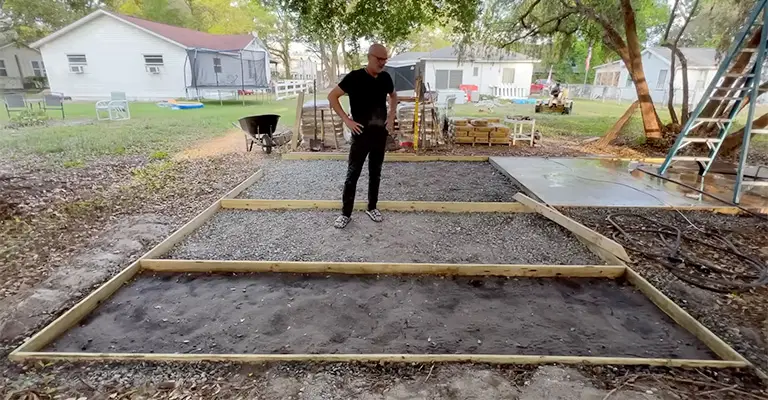
You can build your property’s foundation cost-efficiently and environmentally friendly by compacting rubble into a usable subgrade. Plate compactors can be used to compact rubble.
Materials are compressed into a flat, uniform layer by a plate compactor. In order to make fine rubble easier to work with and to be used as a subgrade, you can compact it with a plate compactor quickly and effectively.
During compaction, materials are crushed together so that they become denser and more solid. Particles are closer together when the material is denser.
There isn’t much difference between operating a plate compactor and operating a lawn mower. You should be able to operate a plate compactor if you’ve operated a lawn mower before.
What Makes A Good Concrete Foundation?
The best concrete foundation for your house is essential, whether you are building a new house or renovating an old one.
The purpose of this section is to give you the basic information you need to build a quality foundation and keep you from making common mistakes that may have structural consequences later on.
The following factors should be considered when laying a concrete foundation for your home or any other structure.
Good Soil
When you are building a foundation for your house, you should determine the type of soil you have. Depending on the soil type, moisture content, compaction, and topography, the strength of the subgrade varies.
Subgrade strength measures how well the soil can support the load placed on the foundation. A soil test should be performed on your property before you lay your concrete foundation down if you do not know the type of soil you have.
It is also important to ensure that the soil is free of organic matter, such as grass or fallen leaves. Moisture is released as organic matter decomposes.
It is possible for soil to become loose due to moisture. You may have problems compacting and setting your subgrade if there is a significant amount of decomposing organic matter.
A Good Subgrade
Under a concrete slab, there is a subgrade. Your foundation’s stability can be increased by providing a solid subgrade beneath the foundation.
It is important to compact the subgrade in order to eliminate cracks, voids, or other gaps that could weaken the foundation. The compacting process also ensures that the soil is level and removes any air pockets.
An improper subgrade, however, can lead to cracks, sinks, shifts, and warps in a foundation.
There are many ways in which subgrade cracks can appear. It could be a localized area of soft subgrade caused by seepage of water, or an earthquake could cause the subgrade to shift and break loose.
Whatever the case, moisture is able to seep into these cracks, weakening the structure.
What Is The Recommended Thickness For Concrete Overlay?
In order to achieve a beautiful, flawless concrete overlay, thickness is an important factor to consider. For concrete overlays to be durable, they must be thick enough to protect the underlying concrete.
One to two inches should be the average thickness. You should keep in mind that this is only a guideline, and your circumstances may vary.
How Long Should You Expect Concrete Overlay To Last?
The durability of concrete overlay might be on your mind. However, concrete overlays won’t last forever. Although they last longer than most house paintings, they won’t last forever. As long as your home lasts, you can expect them to last as well.
Concrete overlays have a life expectancy that depends on several factors, including the weather and how well they are maintained.
The Bottom Line
The rubble must be properly crushed before concrete can be poured over it. To break up large rubble pieces into smaller ones, you can use a sledgehammer or a jackhammer.
Using a plate compactor, you can compact the rubble once it has been broken up into finer particles. A solid surface should be formed by compacting and hardening the rubble.

